ഡിസ്കവറി സ്പേസ് ഷട്ടിൽ
| Discovery OV-103 | |
|---|---|
 Space Shuttle Discovery launches from NASA Kennedy Space Center Launch Pad 39A on mission STS-124 on May 31, 2008. | |
| OV designation | OV-103 |
| Country | United States |
| Contract award | January 29, 1979 |
| Named after | Discovery (1602), HMS Discovery (1774), HMS Discovery (1874), RRS Discovery (1901) |
| Status | Retired, on display at the Steven F. Udvar-Hazy Center in Chantilly, Virginia[1] |
| First flight | STS-41-D ഓഗസ്റ്റ് 30, 1984 – September 5, 1984 |
| Last flight | STS-133 ഫെബ്രുവരി 24, 2011 – March 9, 2011 |
| Number of missions | 39 |
| Crews | 252[2] |
| Time spent in space | 365 days, 22 hours, 39 minutes, 33 seconds |
| Distance travelled | 148,221,675 mi (238,539,663 km)[3] |
| Satellites deployed | 31 (including Hubble Space Telescope) |
| Mir dockings | 1[3] |
| ISS dockings | 13[3] |

ഡിസ്കവറി സ്പേസ് ഷട്ടിൽ (Orbiter Vehicle Designation: OV-103) നാസയുടെ സ്പേസ് ഷട്ടിൽ പദ്ധതിയിൽ നിർമ്മിക്കപ്പെട്ട അഞ്ചു വാഹനങ്ങളിൽ മൂന്നാമത്തെ ബഹിരാകാശവാഹനം. [4]ഇതിന്റെ 27 വർഷത്തെ ചരിത്രത്തിൽ 39 തവണ തൊടുത്തുവിടുകയും തിരികെയിറങ്ങുകയും ചെയ്തിട്ടുണ്ട്. ഐ സമയം വരെ മറ്റേതൊരു ബഹിരാകാശവാഹനവും ചെയ്യാത്തത്ര ബഹിരാകാശയാത്രകൾ ഡിസ്കവറി ചെയ്തിട്ടുണ്ട്. ഡിസ്കവറിയുടെ ആദ്യ യാത്ര, 1984 ആഗസ്റ്റ് 30 തൊട്ട് സെപ്റ്റംബർ 5 വരെ ആയിരുന്നു. ഈ ദൗത്യം STS-41-D എന്നറിയപ്പെടുന്നു. [5]
കൊളംബിയ, ചലഞ്ചർ എന്നിവയ്ക്കു ശേഷമാണ് ഇത് ഉപയോഗിക്കാൻ ആരംഭിച്ചത്. [6]ഇതിന്റെ അവസാന ദൗത്യം STS-133 എന്നറിയപ്പെടുന്നു. ഇത്, 2011 ഫെബ്രുവരി 24 നായിരുന്നു.[7] കെന്നഡി സ്പേസ് സെന്ററിൽ അത് അവസാനമായി നിലം തൊട്ടത് ആ വർഷം മാർച്ച് 9നായിരുന്നു. ഒരു മുഴുവൻ വർഷം സ്പേസിൽ ചെലവഴിച്ചശേഷമാണ് അത് തന്റെ അവസാന യാത്ര അവസാനിപ്പിച്ചത്. ഈ ദൗത്യത്തിൽ അത് ഗവേഷണത്തിലും ഇന്റെർനാഷണൽ സ്പേസ് സ്റ്റേഷന്റെ വിപുലീകരണത്തിലും സഹായിച്ചു. അത് ഹബ്ബിൾ സ്പേസ് ടെലിസ്കോപ്പ്അതിന്റെ ഭ്രമണപഥത്തിലെത്തിക്കുകയും ചെയ്തു. ഇതാണ് ദൗത്യത്തിൽനിന്നും വിരമിക്കുന്ന ഉപയോഗക്ഷമമായ ആദ്യ സ്പേസ് ഷട്ടിൽ. തുടർന്ന്, എൻഡവർ, അറ്റ്ലാൻഡിസ് എന്നിവയും ഇതുപോലെ പ്രവർത്തനം അവസാനിപ്പിച്ചു.
ചരിത്രം[തിരുത്തുക]
ചരിത്രത്തിൽ, പര്യവേഷണത്തിനായുള്ള കപ്പലുകൾക്കാണ് സാധാരണ ഡിസ്കവറി എന്ന പേർ നൽകിയിട്ടുള്ളത്. [4] primarily HMS Discovery,[8]ക്യാപ്റ്റൻ ജയിംസ് കുക്ക് തന്റെ പര്യവേക്ഷണങ്ങൾക്കായി ഉപയോഗിച്ചിരുന്നതാണ്, HMS Discovery. അദ്ദേഹത്തിന്റെ അവസാന പര്യവേഷണത്തിനായി ഉപയോഗിച്ച ഈ കപ്പൽ 1776 മുതൽ 1779 വരെ സഞ്ചരിച്ചു. 1610–1611വരെ വടക്കുപടിഞ്ഞാറു വഴിത്താര കണ്ടുപിടിക്കാൻ ഹഡ്സൺ ഉൾക്കടലിൽ ഹെൻറി ഹഡ്സൺ നടത്തിയ തിരച്ചിലിന് ഡിസ്കവറി എന്ന കപ്പലാണ് ഉപയോഗിച്ചത്. [9]
ഡിസ്കവറി ഹബ്ബിൾ സ്പേസ് ടെലസ്കോപ്പിനെ സ്പെസിലെ ഭ്രമണപഥത്തിലെത്തിച്ചു. രണ്ടാമത്തെയും (STS-82) മൂന്നാമത്തെയും (STS-103) ഹബ്ബിളിനു സർവീസ് ചെയ്യാനുള്ള ദൗത്യങ്ങളും ഏറ്റെടുത്തു. അത് ഉളീസസ്സ് അന്വേഷണപേടകം ഭ്രമണപഥത്തിലെത്തിച്ചു. മൂന്നു tracking and data relay satellite (TDRS) കളും ബഹിരാകാശപഥത്തിലെത്തിച്ചു. ഇതുകൂടാതെ അനേകം ദൗത്യങ്ങൾ ഡിസ്കവറി വിജയിപ്പിച്ചിട്ടുണ്ട്.
ഇവ കൂടാതെ 1986ൽ സൈനികാവശ്യങ്ങൾക്കായും ഈ ഷട്ടിൽ ഉപയോഗിക്കാൻ തുനിഞ്ഞിട്ടുണ്ട്. പക്ഷെ ചലഞ്ചർ ദുരന്തം ഈ ദൗത്യത്തിൽനിന്നും എയർഫോഴ്സിനെ പിന്തിരിപ്പിച്ചു. [10]
ഡിസ്കവറി അതിന്റെ അവസാന ദൗത്യമായ STS 133 2011 മാർച്ച് 9നാണ് നടത്തിയത്. അമേരിക്കയിലെ വെർജീനിയായിലെ സ്മിത്സോണിയൻ ഇൻസ്റ്റിറ്റ്യൂട്ടിന്റെ ഭാഗമായ നാഷണൽ എയർ ആന്റ് സ്പേസ് മ്യൂസിയത്തിന്റെ സ്റ്റീവൻ എഫ് ഉദ്വാർ-ഹെഇസി സെന്ററിൽ പ്രദർശിപ്പിക്കുന്നു.[1]
ഡിസ്കവറി സ്പേസ് ഷട്ടിലിന്റെ നിർമ്മാണത്തിലെ നാഴികക്കല്ലുകൾ[തിരുത്തുക]
| Date | Milestone[11] |
|---|---|
| 1979 ജനുവരി 29 | Contract Award to Rockwell International's Space Transportation Systems Division in Downey, California |
| 1979 August 27 | Start long lead fabrication of Crew Module |
| 1980 June 20 | Start fabrication lower fuselage |
| 1980 November 10 | Start structural assembly of aft-fuselage |
| 1980 December 8 | Start initial system installation aft fuselage |
| 1981 March 2 | Start fabrication/assembly of payload bay doors |
| 1981 October 26 | Start initial system installation, crew module, Downey |
| 1982 January 4 | Start initial system installation upper forward fuselage |
| 1982 March 16 | Midfuselage on dock, Palmdale, California |
| 1982 March 30 | Elevons on dock, Palmdale |
| 1982 April 30 | Wings arrive at Palmdale from Grumman |
| 1982 April 30 | Lower forward fuselage on dock, Palmdale |
| 1982 July 16 | Upper forward fuselage on dock, Palmdale |
| 1982 August 5 | Vertical stabilizer on dock, Palmdale |
| 1982 September 3 | Start of Final Assembly |
| 1982 October 15 | Body flap on dock, Palmdale |
| 1983 January 11 | Aft fuselage on dock, Palmdale |
| 1983 February 25 | Complete final assembly and closeout installation, Palmdale |
| 1983 February 28 | തുടക്ക സംവിധാനം പരിശോധന തുടങ്ങുന്നു, പവർ ഓണാക്കുന്നു, Palmdale |
| 1983 May 13 | തുടക്ക സംവിധാനം പരിശോധന പൂർത്തിയാക്കുന്നു. |
| 1983 July 26 | ഉപസംവിധാനം പരിശോധിക്കുന്നു. |
| 1983 August 12 | അവസാന അംഗീകാരം നൽകുന്നു. |
| 1983 October 16 | Rollout from Palmdale |
| 1983 November 5 | Overland transport from Palmdale to Edwards Air Force Base |
| 1983 November 9 | കെന്നഡി സ്പേസ് സെന്ററിലേയ്ക്ക് മാറ്റുന്നു. |
| 1984 June 2 | Flight Readiness Firing |
| 1984 August 30 | ആദ്യ പറക്കൽ (STS-41-D) |
പുതുക്കലും പ്രത്യേകതകളും[തിരുത്തുക]
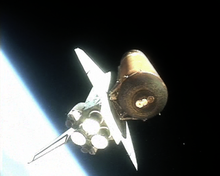
കൊളംബിയയെക്കാൾ ഭാരം കുറഞ്ഞതാണ് ഡിസ്കവറി.6,870 pounds (3,120 kg) [12] 1983ൽ കെന്നെഡി സ്പെസ് സെന്ററിലേയ്ക്ക് കൊണ്ടുപോകുന്നസമയം ഡിസ്കവറി ചലഞ്ചറിനെപ്പോലെ പുതുക്കാൻ തീരുമനിച്ചിരുന്നു. പക്ഷെ, ചലഞ്ചർ ദുരന്തം ഇതു നിർത്തിവച്ചു. [13]
1995ൽ 9 മാസത്തോളം കാലിഫോർണിയയിലെ പാംഡേലിൽ ഡിസ്കവറിയെ കേടുപോക്കി. ക്രയോജനിക് എഞ്ചിന്റെ അഞ്ചാമത് സെറ്റ് ഇതിൽ പിടിപ്പിക്കുകയും ഇന്റെർനാഷണൽ സ്പേസ് സ്റ്റേഷനുമായി ബന്ധപ്പെട്ട ദൗത്യങ്ങളെ സുഗമമാക്കാൻ വേണ്ട ബഹിർഭാഗത്തുള്ള എയർലോക്കിംഗ് സിസ്റ്റവും ചേർക്കുകയും ചെയ്തു.
അങ്ങനെയുൾപ്പെടുത്തിയ മാറ്റങ്ങൾ ഡിസ്കവറിയെ മറ്റു സ്പേസ് ഷട്ടിലുകളേക്കാൾ വലുതാക്കിമാറ്റി. [2]
പറക്കലുകൾ[തിരുത്തുക]

അവസാന മിഷനോടുകൂടി ഡിസ്കവറി 149 million miles (238 million km) ദൂരം 39 വ്യത്യസ്ത ദൗത്യങ്ങളിലായി സഞ്ചരിച്ചുകഴിഞ്ഞതായി കണക്കാക്കിയിരിക്കുന്നു. 5,830 പ്രാവശ്യം പ്രദക്ഷിണം നടത്തി. 27 വർഷത്തോളമായി 365 ദിനംഭ്രമണപഥത്തിൽ ചിലവൊഴിച്ചു. [14] അത് കൊളബിയ, ചലഞ്ചർ എന്നിവ ബാക്കിവച്ച ദൗത്യങ്ങളും എറ്റെടുത്തു.
ഡിസ്കവറിയുടെ പ്രധാന ദൗത്യങ്ങൾ[തിരുത്തുക]
- STS-41-D: Space Shuttle Discovery's maiden spaceflight with the second American woman in space, Judith Resnik
- STS-51-D: Carried first incumbent United States member of Congress into space, Senator Jake Garn (R–Utah)
- STS-26: First "Return to Flight" after Challenger disaster (STS-51-L)
- STS-31: Launch of the Hubble Space Telescope
- STS-48: Launch of the Upper Atmosphere Research Satellite
- STS-60: First Russian launched in an American spacecraft (Sergei Krikalev)
- STS-63: First female shuttle pilot Eileen Collins.[2]
- STS-95: Second flight of John Glenn, who was 77 years of age at that time, the oldest man in space and third incumbent member of Congress to enter space
- STS-96: First Orbiter Shuttle and first mission flight to dock with the International Space Station[2]
- STS-92: The 100th Space Shuttle mission
- STS-114: Second "Return to Flight" missions after Columbia disaster (STS-107)
- STS-116: First night time launch of a Space Shuttle since the Columbia disaster. Last Shuttle launch from LC-39B
- STS-131: Longest mission for this Orbiter with 15 days to its credit
- STS-133: Final mission for this Space Shuttle
Flights listing[തിരുത്തുക]
| # | Date | Designation | Notes | Length of journey |
|---|---|---|---|---|
| 1 | ഓഗസ്റ്റ് 30, 1984 | STS-41-D | First Discovery mission: Judith Resnik became second American woman in Space. Three communications satellites were put into orbit, including LEASAT F2. | 6 days, 00 hours, 56 minutes, 04 seconds |
| 2 | നവംബർ 8, 1984 | STS-51-A | Launched two and rescued two communications satellites including LEASAT F1. | 7 days, 23 hours, 44 minutes, 56 seconds |
| 3 | ജനുവരി 24, 1985 | STS-51-C | Launched DOD Magnum ELINT satellite. | 3 days, 01 hours, 33 minutes, 23 seconds- |
| 4 | ഏപ്രിൽ 12, 1985 | STS-51-D | Launched two communications satellites including LEASAT F3. | 6 days, 23 hours, 55 minutes, 23 seconds |
| 5 | ജൂൺ 17, 1985 | STS-51-G | Launched two communications satellites, Sultan Salman al-Saud becomes first Saudi Arabian in space. | 7 days, 01 hours, 38 minutes, 52 seconds |
| 6 | ഓഗസ്റ്റ് 27, 1985 | STS-51-I | Launched two communications satellites including LEASAT F4. Recovered, repaired, and redeployed LEASAT F3. | 7 days, 02 hours, 17 minutes, 42 seconds |
| 7 | സെപ്റ്റംബർ 29, 1988 | STS-26 | Return to flight after Space Shuttle Challenger disaster, launched TDRS. | 4 days, 01 hours, 00 minutes, 11 seconds |
| 8 | മാർച്ച് 13, 1989 | STS-29 | Launched TDRS. | 4 days, 23 hours, 38 minutes, 52 seconds |
| 9 | നവംബർ 22, 1989 | STS-33 | Launched DOD Magnum ELINT satellite. | 5 days, 00 hours, 06 minutes, 49 seconds |
| 10 | ഏപ്രിൽ 24, 1990 | STS-31 | Launch of Hubble Space Telescope (HST). | 5 days, 01 hours, 16 minutes, 06 seconds |
| 11 | ഒക്ടോബർ 6, 1990 | STS-41 | Launch of Ulysses. | 4 days, 02 hours, 10 minutes, 04 seconds |
| 12 | ഏപ്രിൽ 28, 1991 | STS-39 | Launched DOD Air Force Program-675 (AFP-675) satellite. | 8 days, 07 hours, 22 minutes, 23 seconds |
| 13 | സെപ്റ്റംബർ 12, 1991 | STS-48 | Upper Atmosphere Research Satellite (UARS). | 5 days, 08 hours, 27 minutes, 38 seconds |
| 14 | ജനുവരി 22, 1992 | STS-42 | International Microgravity Laboratory-1 (IML-1). | 8 days, 01 hours, 14 minutes, 44 seconds |
| 15 | ഡിസംബർ 2, 1992 | STS-53 | Department of Defense payload. | 7 days, 07 hours, 19 minutes, 47 seconds |
| 16 | ഏപ്രിൽ 8, 1993 | STS-56 | Atmospheric Laboratory (ATLAS-2). | 9 days, 06 hours, 08 minutes, 24 seconds |
| 17 | സെപ്റ്റംബർ 12, 1993 | STS-51 | Advanced Communications Technology Satellite (ACTS). | 9 days, 20 hours, 11 minutes, 11 seconds |
| 18 | ഫെബ്രുവരി 3, 1994 | STS-60 | First Shuttle-Mir mission; Wake Shield Facility (WSF). | 8 days, 07 hours, 09 minutes, 22 seconds |
| 19 | സെപ്റ്റംബർ 9, 1994 | STS-64 | LIDAR In-Space Technology Experiment (LITE). | 10 days, 22 hours, 49 minutes, 57 seconds |
| 20 | ഫെബ്രുവരി 3, 1995 | STS-63 | Rendezvous with Mir space station. | 8 days, 06 hours, 29 minutes, 36 seconds |
| 21 | ജൂലൈ 13, 1995 | STS-70 | 7th Tracking and Data Relay Satellite (TDRS). | 8 days, 22 hours, 20 minutes, 05 seconds |
| 22 | ഫെബ്രുവരി 11, 1997 | STS-82 | Servicing Hubble Space Telescope (HST) (HSM-2). | 9 days, 23 hours, 38 minutes, 09 seconds |
| 23 | ഓഗസ്റ്റ് 7, 1997 | STS-85 | Cryogenic Infrared Spectrometers and Telescopes (CRISTA). | 11 days, 20 hours, 28 minutes, 07 seconds |
| 24 | ജൂൺ 2, 1998 | STS-91 | Final Shuttle/Mir Docking Mission. | 9 days, 19 hours, 55 minutes, 01 seconds |
| 25 | ഒക്ടോബർ 29, 1998 | STS-95 | SPACEHAB, second flight of John Glenn, Pedro Duque becomes first Spaniard in space. | 8 days, 21 hours, 44 minutes, 56 seconds |
| 26 | മേയ് 27, 1999 | STS-96 | Resupply mission for the International Space Station. | 9 days, 19 hours, 13 minutes, 57 seconds |
| 27 | ഡിസംബർ 19, 1999 | STS-103 | Servicing Hubble Space Telescope (HST) (HSM-3A). | 7 days, 23 hours, 11 minutes, 34 seconds |
| 28 | ഒക്ടോബർ 11, 2000 | STS-92 | International Space Station Assembly Flight (carried and assembled the Z1 truss); 100th Shuttle mission. | 12 days, 21 hours, 43 minutes, 47 seconds |
| 29 | മാർച്ച് 8, 2001 | STS-102 | International Space Station crew rotation flight (Expedition 1 and Expedition 2) | 12 days, 19 hours, 51 minutes, 57 seconds |
| 30 | ഓഗസ്റ്റ് 10, 2001 | STS-105 | International Space Station crew and supplies delivery (Expedition 2 and Expedition 3) | 11 days 21 hours, 13 minutes, 52 seconds |
| 31 | ജൂലൈ 26, 2005 | STS-114 | "Return To Flight" mission since Space Shuttle Columbia disaster; International Space Station (ISS) supplies delivery, new safety procedures testing and evaluation, Multi-Purpose Logistics Module (MPLM) Raffaello. | 13 days, 21 hours, 33 minutes, 00 seconds |
| 32 | ജൂലൈ 4, 2006 | STS-121 | Second "Return To Flight" mission since the Space Shuttle Columbia disaster; International Space Station (ISS) supplies delivery, test new safety and repair techniques. | 12 days, 18 hours, 37 minutes, 54 seconds |
| 33 | ഡിസംബർ 9, 2006 | STS-116 | ISS crew rotation and assembly (carries and assembles the P5 truss segment); Last flight to launch on pad 39-B; First night launch since Space Shuttle Columbia disaster. |
12 days, 20 hours, 44 minutes, 16 seconds |
| 34 | ഒക്ടോബർ 23, 2007 | STS-120 | ISS crew rotation and assembly (carries and assembles the Harmony module). | 15 days, 02 hours, 23 minutes, 55 seconds |
| 35 | മേയ് 31, 2008 | STS-124 | ISS crew rotation and assembly (carries and assembles the Kibō JEM PM module). | 13 days, 18 hours, 13 minutes, 07 seconds |
| 36 | മാർച്ച് 15, 2009 | STS-119 | International Space Station crew rotation and assembly of a fourth starboard truss segment (ITS S6) and a fourth set of solar arrays and batteries. Also replaced a failed unit for a system that converts urine to drinking water. |
12 days, 19 hours, 29 minutes, 33 seconds |
| 37 | ഓഗസ്റ്റ് 28, 2009 | STS-128 | International Space Station crew rotation and ISS resupply using the Leonardo Multi-Purpose Logistics Module. Also carried the C.O.L.B.E.R.T treadmill named after Stephen Colbert | 13 days 20 hours, 54 minutes, 40 seconds |
| 38 | ഏപ്രിൽ 5, 2010 | STS-131 | ISS resupply using the Leonardo Multi-Purpose Logistics Module. The mission also marked the 1st time that 4 women were in space & the 1st time that 2 Japanese astronauts were together in space station[15] | 15 days 2 hours, 47 minutes 11 seconds‡ |
| 39 | ഫെബ്രുവരി 24, 2011 | STS-133 | The mission launched at 4:53 pm EST on February 24, was carrying the Permanent Multipurpose Module (PMM) Leonardo, the ELC-4 and Robonaut 2 to the ISS.[16] | 12 days 19 hours, 4 minutes, 50 seconds |
‡ Longest shuttle mission for Discovery
– shortest shuttle mission for Discovery
Mission and tribute insignias[തിരുത്തുക]
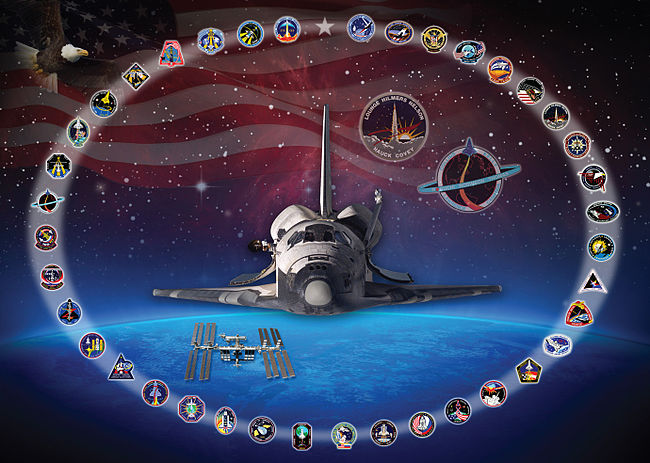
| Mission insignias for Discovery flights | |||||||
|---|---|---|---|---|---|---|---|
 |
 |
 |
 |
 |
 |
 |
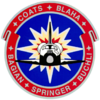 |
 |
 |
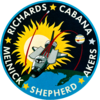 |
 |
 |
 |
 |
 |
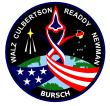 |
 |
 |
 |
 |
 |
 |
 |
 |
 |
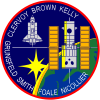 |
 |
 |
 |
 |
 |
 |
 |
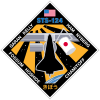 |
 |
 |
 |
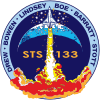 | |
Gallery[തിരുത്തുക]
 |
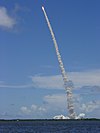 |
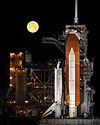 |
 |
 |
| The launch of STS-41-D, Discovery’s first mission. | STS-121 launched on July 4, 2006 – the first and only shuttle to launch on Independence Day. | STS-119 on the night of March 11, 2009. | Discovery sits atop a modified Boeing 747 as it touches down. | Discovery lands after its first flight, STS-41-D. |
 |
 |
 |
 |
 |
| Discovery performing the Rendezvous pitch maneuver prior to docking with the International Space Station. | The Space Shuttle Discovery soon after landing | Modified Boeing 747 carrying Discovery. | STS-124 comes to a close as Discovery lands at the Kennedy Space Center. | Discovery's final touchdown on Kennedy Space Center's runway, concluding the STS-133 mission and Discovery's 27-year career. |
See also[തിരുത്തുക]
- List of human spaceflights
- List of Space Shuttle crews
- List of space shuttle missions
- Timeline of Space Shuttle missions
അവലംബം[തിരുത്തുക]
![]() This article incorporates public domain material from websites or documents of the National Aeronautics and Space Administration.
This article incorporates public domain material from websites or documents of the National Aeronautics and Space Administration.
- ↑ 1.0 1.1 "Space Shuttle Discovery Joins the National Collection". April 12, 2011. Archived from the original on 2012-01-21. Retrieved July 31, 2011.
- ↑ 2.0 2.1 2.2 2.3 "Space Shuttle Discovery Facts". Florida Today. April 10, 2011.
- ↑ 3.0 3.1 3.2 NASA (October 2010). "NASAfacts Discovery (OV-103)" (PDF). Archived from the original (PDF) on 2010-10-26. Retrieved October 21, 2010.
- ↑ 4.0 4.1 NASA (2007). "Space Shuttle Overview: Discovery (OV-103)". National Aeronautics and Space Administration. Archived from the original on 2007-11-07. Retrieved November 6, 2007.
- ↑ "10 Cool Facts About NASA's Space Shuttle Discovery | Space Shuttle Retirement". Space.com. Retrieved 2013-08-30.
- ↑ "Discovery's last mission flight to space begun". February 24, 2011. Archived from the original on 2011-07-16. Retrieved March 9, 2011.
- ↑ "Discovery's Final Touchdown A Success". redOrbit.com. Retrieved March 9, 2011.
- ↑ "Discovery (OV-103)". science.ksc.nasa.gov. Archived from the original on 2021-02-09. Retrieved February 2015.
{{cite web}}: Check date values in:|accessdate=(help) - ↑ "How Did the Space Shuttle Discovery Get Its Name?". Space.com. Retrieved February 2015.
{{cite web}}: Check date values in:|accessdate=(help) - ↑ "Space Transportation System Haer No. TX-116" (PDF). NASA.gov. Retrieved February 2015.
{{cite web}}: Check date values in:|accessdate=(help) - ↑ "Discovery (OV-103)". NASA/KSC. Archived from the original on 2011-06-10. Retrieved March 10, 2011.
- ↑ "Space Shuttle Overview: Discovery (OV-103)". NASA. Archived from the original on 2007-11-07. Retrieved March 10, 2011.
- ↑ Lardas, Mark (2012). Space Shuttle Launch System: 1972–2004. Osprey Publishing. p. 37.
- ↑ Dunn, Marcia (March 9, 2011). "Space shuttle Discovery lands, ends flying career". Salt Lake Tribune. Associated Press. Retrieved March 10, 2011.
- ↑ FOUR WOMEN, TWO JAPANESE IN SPACE AT SAME TIME Archived 2011-07-25 at the Wayback Machine. Asian American Press, April 8, 2010
- ↑ "Shuttle Discovery takes off on its final flight". CNN. February 24, 2011. Retrieved March 10, 2011.
